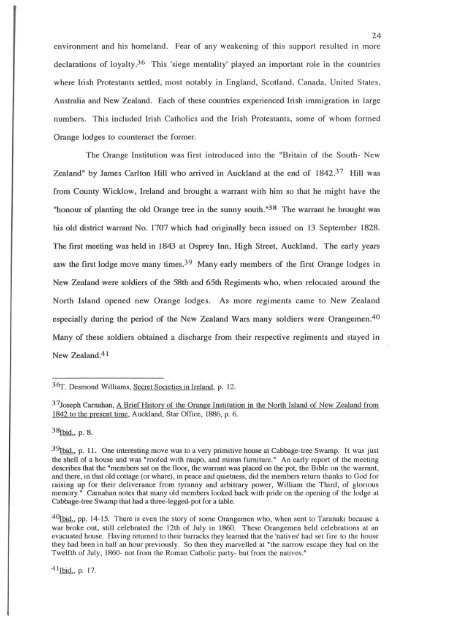TRANSPLANTED IRISH INSTITUTIONS - University of Canterbury
TRANSPLANTED IRISH INSTITUTIONS - University of Canterbury
TRANSPLANTED IRISH INSTITUTIONS - University of Canterbury
You also want an ePaper? Increase the reach of your titles
YUMPU automatically turns print PDFs into web optimized ePapers that Google loves.
24<br />
environment and his homeland. Fear <strong>of</strong> any weakening <strong>of</strong> this support resulted in more<br />
declarations <strong>of</strong> loyalty.36 This 'siege mentality' played an important role in the countries<br />
where Irish Protestants settled, most notably in England, Scotland, Canada, United States,<br />
Australia and New Zealand. Each <strong>of</strong> these countries experienced Irish immigration in large<br />
numbers. This included Irish Catholics and the Irish Protestants, some <strong>of</strong> whom formed<br />
Orange lodges to counteract the former.<br />
The Orange Institution was first introduced into the "Britain <strong>of</strong> the South- New<br />
Zealand" by lames Carlton Hill who arrived in Auckland at the end <strong>of</strong> 1842.3 7 Hill was<br />
from County Wicklow, Ireland and brought a warrant with him so that he might have the<br />
"honour <strong>of</strong> planting the old Orange tree in the sunny south. "38 The warrant he brought was<br />
his old district warrant No. 1707 which had originally been issued on 13 September 1828.<br />
The first meeting was held in 1843 at Osprey Inn, High Street, Auckland. The early years<br />
saw the first lodge move many times. 39 Many early members <strong>of</strong> the first Orange lodges in<br />
New Zealand were soldiers <strong>of</strong> the 58th and 65th Regiments who, when relocated around the<br />
North Island opened new Orange lodges.<br />
As more regiments came to New Zealand<br />
especially during the period <strong>of</strong> the New Zealand Wars many soldiers were Orangemen. 40<br />
Many <strong>of</strong> these soldiers obtained a discharge from their respective regiments and stayed in<br />
New Zealand. 41<br />
3&r. Desmond Williams, Secret Societies in Ireland, p. 12.<br />
37Joseph Carnahan, A Brief History <strong>of</strong> the Orange Institution in the North Island <strong>of</strong> New Zealand from<br />
1842 to the present time, Aucldand, Star Office, 1886, p. 6.<br />
38Ibid., p. 8.<br />
39Jbid., p. 11. One interesting move was to a very primitive house at Cabbage-tree Swamp. It was just<br />
the shell <strong>of</strong> a house and was "ro<strong>of</strong>ed with rau po , and minus furniture." An early report <strong>of</strong> the meeting<br />
describes that the "members sat on the noor, the warrant was placed on the pot, the Bible on the warrant,<br />
and there, in that old cottage (or whare), in peace and quietness, did the members return thanks to God for<br />
raising up for their deliverance from tyranny and arbitrary power, William the Third, <strong>of</strong> glorious<br />
memory." Carnahan notes that many old members looked back with pride on the opening <strong>of</strong> the lodge at<br />
Cabbage-tree Swamp that had a three-legged-pot for a table.<br />
4DJbi.d., pp. 14-15. There is even the story <strong>of</strong> some Orangemen who, when sent to Taranaki because a<br />
war broke out, still celebrated the 12th <strong>of</strong> July in 1860. These Orangemen held celebrations at an<br />
evacuated house. Having returned to their barracks they learned that the 'natives' had set fire to the house<br />
they had been in half an hour previously. So then they marvelled at "the narrow escape they had on the<br />
Twelfth <strong>of</strong> July, 1860- not from the Roman Catholic party- but from the natives."<br />
4 1Ibid., p. 17.
















